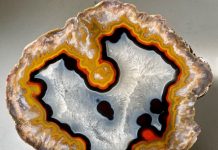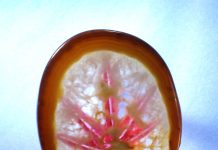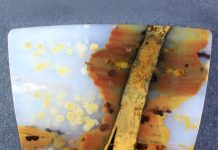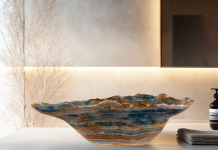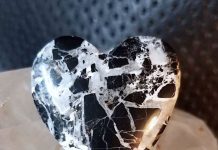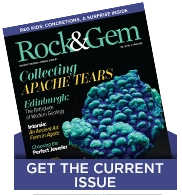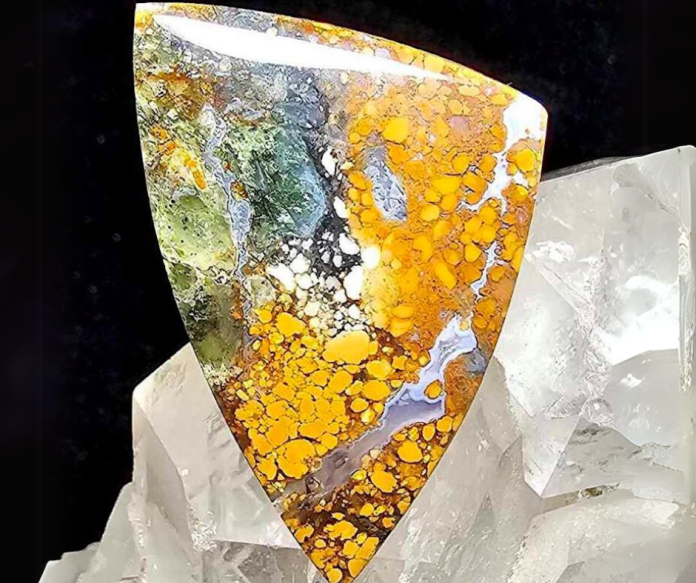
California magnesite plasma agate is a kaleidoscope of minerals. Much like its neighbor from Clear Creek, it contains chalcedony, serpentine, jadeite and chromite. Mixed like a conglomerate with magnesite, at times, you can still find specs of cinnabar in it. The green is predominantly agatized serpentine, where it mixes with the serpentine layers in that area, as well as large outcroppings of magnesite. The magnesite in that region will yield various colors depending on its mix of minerals. You will see pure white to dark gold and orange. Much of what’s found is in layers, so the plasma portions usually run in seams. The seams are sandwiched between layers of magnesite mixed with agate, giving it a desired contrasting pattern.
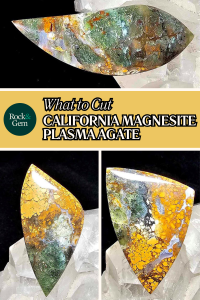 Buying Magnesite Plasma Agate
Buying Magnesite Plasma Agate
When buying magnesite plasma agate, you can’t always rely on what you see on the outside. Since it cuts like a conglomerate, the patterns will rapidly change inside. It will also contain many porous, crumbly pockets and possibly fractures. Beware, there will be a good deal of waste material when cutting this from rough material.
If you choose to buy slabs, that might be to your advantage. If you can wet the slab, you can see where the water dries first. This will show any differences in minerals, so you know where the undercutting might be located. Softer material dries the quickest. The agatized material will dry much more slowly. If there are any fractures, the water usually sinks in and dries the slowest, making it easy for the human eye to see where the fractures are. Even with all these warnings, there will still be a great deal of exceptional areas to use for designing cabochons.
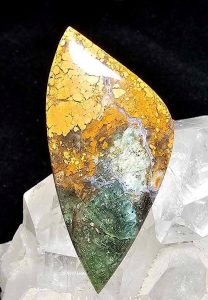 Getting Started
Getting Started
When starting to cut slabs, the Clear Creek variation had no particular direction to cut, but with the magnesite plasma, I would suggest north to south, like cutting a sandwich in half. This way, you get a good mix of the magnesite on the top and bottom edges to mix into your designs. You can also crosscut and extract the first slab or two to get primarily just the magnesite, and then cut into pure gem green plasma agate. It’s all a preference to the lapidary artist. Many pieces will be conglomerate-like and have green nodules encased in magnesite, so it won’t matter which way you cut it.
Once your slabs are cut, it’s time to design your preforms. This is the time to wet your material to get an idea of where the fractures are located and get an idea of where the undercutting might occur. You can simply draw out your cabs around any fractures, utilize all the good areas and trim off any porous, crumbly spots.
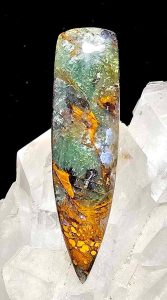 Making Your Cabochon
Making Your Cabochon
The cabbing process starts on the 80-grit steel, where you will shape and dome your cab. From here, I like using a 220-grit steel wheel to smooth out the cab and retain an equal height across the dome. Once you move on to either a 140 or 280 soft resin wheel, this is where you want to continue drying the cab periodically and check for any undercutting. Most of the magnesite is fairly solid and decently hard, but it will undercut more than the agate portions. Once you reach the 600-grit soft resin wheel, be sure not to move on any further until all the remaining scratches are gone.
Also, it should start taking a nice polish by this point. Continue your way to the 1200 and 8k grit, and this will yield a beautifully polished cab. One thing I like to do with magnesite is use a Foredom rotary tool or even a Dremel, with a felt tip and Zam polishing compound. This will bring up the shine on the magnesite and equal the polish between all the various minerals in this material. Be sure not to get it too hot or the agatized areas might start to fracture from the heat. Go little bits at a time, wipe with a dry rag, and continue as needed. It should only take 15 to 30 seconds to achieve a beautiful polish across the entire cab.
This story about California magnesite plasma agate previously appeared in Rock & Gem magazine. Click here to subscribe. Story by Russ Kaniuth.


